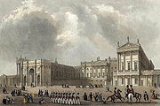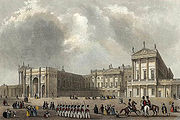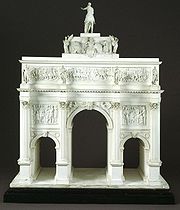
Marble Arch
Encyclopedia


Carrara
Carrara is a city and comune in the province of Massa-Carrara , notable for the white or blue-grey marble quarried there. It is on the Carrione River, some west-northwest of Florence....
marble
Marble
Marble is a metamorphic rock composed of recrystallized carbonate minerals, most commonly calcite or dolomite.Geologists use the term "marble" to refer to metamorphosed limestone; however stonemasons use the term more broadly to encompass unmetamorphosed limestone.Marble is commonly used for...
monument that now stands on a large traffic island at the junction of Oxford Street
Oxford Street
Oxford Street is a major thoroughfare in the City of Westminster in the West End of London, United Kingdom. It is Europe's busiest shopping street, as well as its most dense, and currently has approximately 300 shops. The street was formerly part of the London-Oxford road which began at Newgate,...
, Park Lane
Park Lane (road)
Park Lane is a major road in the City of Westminster, in Central London.-History:Originally a country lane running north-south along what is now the eastern boundary of Hyde Park, it became a fashionable residential address from the eighteenth century onwards, offering both views across Hyde Park...
, and Edgware Road, almost directly opposite Speakers' Corner
Speakers' Corner
A Speakers' Corner is an area where open-air public speaking, debate and discussion are allowed. The original and most noted is in the north-east corner of Hyde Park in London, United Kingdom. Speakers there may speak on any subject, as long as the police consider their speeches lawful, although...
in Hyde Park
Hyde Park, London
Hyde Park is one of the largest parks in central London, United Kingdom, and one of the Royal Parks of London, famous for its Speakers' Corner.The park is divided in two by the Serpentine...
in London
London
London is the capital city of :England and the :United Kingdom, the largest metropolitan area in the United Kingdom, and the largest urban zone in the European Union by most measures. Located on the River Thames, London has been a major settlement for two millennia, its history going back to its...
, England
England
England is a country that is part of the United Kingdom. It shares land borders with Scotland to the north and Wales to the west; the Irish Sea is to the north west, the Celtic Sea to the south west, with the North Sea to the east and the English Channel to the south separating it from continental...
. Until 1851 it stood in front of Buckingham Palace
Buckingham Palace
Buckingham Palace, in London, is the principal residence and office of the British monarch. Located in the City of Westminster, the palace is a setting for state occasions and royal hospitality...
.
Historically, only members of the royal family and the King's Troop, Royal Horse Artillery
King's Troop, Royal Horse Artillery
The King's Troop, Royal Horse Artillery is a ceremonial unit of the British Army. It is a mounted unit and all of its soldiers are trained to drive a team of six horses that pull each of the six First World War-era 13-pounder state saluting guns...
, have been allowed to pass through the arch in ceremonial procession.
The name "Marble Arch" also refers to the locality in west London where the arch is situated, particularly, the southern portion of Edgware Road. There also is an underground station
Marble Arch tube station
Marble Arch is a London Underground station in the City of Westminster. The station is between Lancaster Gate and Bond Street stations on the Central line, and is in Travelcard Zone 1.-History:...
named after it.
History
The arch was designed in 1825 by John NashJohn Nash (architect)
John Nash was a British architect responsible for much of the layout of Regency London.-Biography:Born in Lambeth, London, the son of a Welsh millwright, Nash trained with the architect Sir Robert Taylor. He established his own practice in 1777, but his career was initially unsuccessful and...
as ceremonial entrance to the new Buckingham Palace
Buckingham Palace
Buckingham Palace, in London, is the principal residence and office of the British monarch. Located in the City of Westminster, the palace is a setting for state occasions and royal hospitality...
, which he was then rebuilding from the former Buckingham House. At that time the palace did not yet have its present flat east front, which meant that the inner courtyard, flanked by two wings, was still open on one side. The Marble Arch was placed at the entrance to this open side of the courtyard. Sculpture for the arch was commissioned from John Flaxman
John Flaxman
John Flaxman was an English sculptor and draughtsman.-Early life:He was born in York. His father was also named John, after an ancestor who, according to family tradition, had fought for Parliament at the Battle of Naseby, and afterwards settled as a carrier or farmer in Buckinghamshire...
, Sir Richard Westmacott
Richard Westmacott
Sir Richard Westmacott, Jr., RA was a British sculptor.-Life and career:He studied under his father, Richard Westmacott the Elder, before going to Rome in 1793 to study under Antonio Canova...
, Edward Hodges Baily
Edward Hodges Baily
Edward Hodges Baily RA FRS - was an English sculptor who was born in Downend in Bristol.-Life:...
and John Charles Felix Rossi
John Charles Felix Rossi
-Life:John Charles Felix Rossi was born at Nottingham on 8 March 1762. His father, an Italian from Siena, was a quack doctor at Nottingham, and afterwards at Mountsorrell, Leicestershire. Rossi was sent to the studio of Giovanni Battista Locatelli, an Italian sculptor working in London...
; a bronze equestrian sculpture of George IV by Francis Chantrey was to stand on the top.
Construction began in 1827, but was cut short in 1830 because of rising costs. Work restarted in 1832, this time under the supervision of Edward Blore
Edward Blore
Edward Blore was a 19th century British landscape and architectural artist, architect and antiquary. He was born in Edinburgh, Scotland ....
, who greatly reduced Nash's planned attic stage and omitted its sculpture, including the statue of George IV. The arch was completed in 1833.
The marble soon lost its whiteness in the polluted London atmosphere. In 1847, Sharpe's London Magazine described it as "discoloured by smoke and damp, and in appearance resembling a huge sugar erection in a confectioner's shop window".
In 1851 the arch was moved to its present location, when the new east range of the palace was built, closing in the courtyard. A popular story says that the arch was moved because it was too narrow for the Queen's state coach to pass through, but, in fact, the gold state coach passed under it during Elizabeth II
Elizabeth II of the United Kingdom
Elizabeth II is the constitutional monarch of 16 sovereign states known as the Commonwealth realms: the United Kingdom, Canada, Australia, New Zealand, Jamaica, Barbados, the Bahamas, Grenada, Papua New Guinea, the Solomon Islands, Tuvalu, Saint Lucia, Saint Vincent and the Grenadines, Belize,...
's coronation in 1953.
There are three small rooms inside the rebuilt arch that were used as a police station until 1950, first for the royal constables of the Park and later the Metropolitan Police
Metropolitan police
Metropolitan Police is a generic title for the municipal police force for a major metropolitan area, and it may be part of the official title of the force...
. One policeman stationed there during the early 1860s was Samuel Parkes
Samuel Parkes (VC)
Samuel Parkes VC was an English recipient of the Victoria Cross, the highest and most prestigious award for gallantry in the face of the enemy that can be awarded to British and Commonwealth forces...
, who won the Victoria Cross
Victoria Cross
The Victoria Cross is the highest military decoration awarded for valour "in the face of the enemy" to members of the armed forces of various Commonwealth countries, and previous British Empire territories....
in the Charge of the Light Brigade
Charge of the Light Brigade
The Charge of the Light Brigade was a charge of British cavalry led by Lord Cardigan against Russian forces during the Battle of Balaclava on 25 October 1854 in the Crimean War. The charge was the result of a miscommunication in such a way that the brigade attempted a much more difficult objective...
in 1854, during the Crimean War
Crimean War
The Crimean War was a conflict fought between the Russian Empire and an alliance of the French Empire, the British Empire, the Ottoman Empire, and the Kingdom of Sardinia. The war was part of a long-running contest between the major European powers for influence over territories of the declining...
.
It has been speculated that the arch might be moved across the street to Hyde Park, or to some other more-accessible location, instead of its current position on a large traffic island.
Design
The design of the arch is based on that of the Arch of ConstantineArch of Constantine
The Arch of Constantine is a triumphal arch in Rome, situated between the Colosseum and the Palatine Hill. It was erected to commemorate Constantine I's victory over Maxentius at the Battle of Milvian Bridge on October 28, 312...
in Rome. The attic storey was originally intended to be considerably taller, and embellished with sculpture: an architectural model, made in around 1826, now in the Victoria and Albert Museum
Victoria and Albert Museum
The Victoria and Albert Museum , set in the Brompton district of The Royal Borough of Kensington and Chelsea, London, England, is the world's largest museum of decorative arts and design, housing a permanent collection of over 4.5 million objects...
shows it with a continuous relief of the Battle of Waterloo
Battle of Waterloo
The Battle of Waterloo was fought on Sunday 18 June 1815 near Waterloo in present-day Belgium, then part of the United Kingdom of the Netherlands...
on one side and scenes of naval engagements on the other. In 1829, a bronze equestrian statue of George IV was commissioned from Sir Francis Chantrey, with the intention of placing it on top of the arch. It was instead installed on a plinth in Trafalgar Square
Trafalgar Square
Trafalgar Square is a public space and tourist attraction in central London, England, United Kingdom. At its centre is Nelson's Column, which is guarded by four lion statues at its base. There are a number of statues and sculptures in the square, with one plinth displaying changing pieces of...
.
The friezes intended for the arch were used to decorate Buckingham Palace.Other sculptures originally made for the arch were instead used on the façade of the National Gallery
National Gallery, London
The National Gallery is an art museum on Trafalgar Square, London, United Kingdom. Founded in 1824, it houses a collection of over 2,300 paintings dating from the mid-13th century to 1900. The gallery is an exempt charity, and a non-departmental public body of the Department for Culture, Media...
.
Location
| London Buses | Marble Arch 2 London Buses route 2 London Buses route 2 is a Transport for London contracted bus route in London, England. The service is currently contracted to Arriva London.-History:Route 2 was the last West End bus route that was operated by step-entrance buses other than Routemasters... , 10 London Buses route 10 London Buses route 10 is a Transport for London contracted bus route in London, England, United Kingdom. The service is currently contracted to London United.-History:... , 16 London Buses route 16 London Buses route 16 is a Transport for London contracted bus route in London, England, United Kingdom. The service is currently contracted to Metroline.-History:... , 36 London Buses route 36 London Buses route 36 is a Transport for London contracted bus route in London, United Kingdom. The service is currently contracted to Go-Ahead London.-The Beginning:... , 73 London Buses route 73 London Buses route 73 is a Transport for London contracted bus route in London, United Kingdom. The service is currently contracted to Arriva London... , 74 London Buses route 74 London Buses route 74 is a Transport for London contracted bus route in London, United Kingdom. The service is currently contracted to Go-Ahead London.-History:... , 82 London Buses route 82 London Buses route 82 is a Transport for London contracted bus route in London, United Kingdom. The service is currently contracted to Metroline.-History:... , 137 London Buses route 137 London Buses route 137 is a Transport for London contracted bus route in London, United Kingdom. The service is contracted to Arriva London.-History:... , 159 London Buses route 159 London Buses route 159 is a Transport for London contracted bus route in London, United Kingdom. The service is currently contracted to Arriva London.-History:... , 148, 414, 436 London Buses route 436 London Buses route 436 is a Transport for London contracted bus route in London, United Kingdom. The service is currently contracted to Go-Ahead London.-History:... |
| London Underground | Marble Arch Marble Arch tube station Marble Arch is a London Underground station in the City of Westminster. The station is between Lancaster Gate and Bond Street stations on the Central line, and is in Travelcard Zone 1.-History:...  |
The nearest London Underground station is Marble Arch
Marble Arch tube station
Marble Arch is a London Underground station in the City of Westminster. The station is between Lancaster Gate and Bond Street stations on the Central line, and is in Travelcard Zone 1.-History:...
on the Central Line
Central Line
The Central line is a London Underground line, coloured red on the tube map. It is a deep-level "tube" line, running east-west across London, and, at , has the greatest total length of track of any line on the Underground. Of the 49 stations served, 20 are below ground...
.
The area around the arch forms a major road junction connecting Oxford Street
Oxford Street
Oxford Street is a major thoroughfare in the City of Westminster in the West End of London, United Kingdom. It is Europe's busiest shopping street, as well as its most dense, and currently has approximately 300 shops. The street was formerly part of the London-Oxford road which began at Newgate,...
to the east, Park Lane
Park Lane (road)
Park Lane is a major road in the City of Westminster, in Central London.-History:Originally a country lane running north-south along what is now the eastern boundary of Hyde Park, it became a fashionable residential address from the eighteenth century onwards, offering both views across Hyde Park...
(A4202) to the south, Bayswater Road
Bayswater Road
Bayswater Road is the main road running across the north of Hyde Park, London. To the east Bayswater Road becomes Oxford Street . It is where the fictional upper middle class Forsyte family live in the BBC series the Forsyte Saga...
(A402
A202 road
The A202 is a primary A road in London. It runs from New Cross Gate to London Victoria station. The section forming part of the London Inner Ring Road is known as Vauxhall Bridge Road.-Camberwell New Road:...
) to the west, and Edgware Road (A5) to the north-west. The short road directly to the north of the arch is also known as Marble Arch.
The area once was home to the largest cinema screen in London at the Odeon Marble Arch
Odeon Marble Arch
The Odeon Marble Arch is a cinema located opposite Marble Arch monument at the top of Park Lane, with its main entrance on Edgware Road, London. It is most famous for once housing a vast screen capable of screening films in 70mm....
cinema. The screen was originally over 75 feet (22.9 m) wide. The Odeon showcased 70 mm films in a large circle-and-stalls auditorium. The cinema was converted into a mini-plex in 1997.
The arch is near the largest Marks & Spencer
Marks & Spencer
Marks and Spencer plc is a British retailer headquartered in the City of Westminster, London, with over 700 stores in the United Kingdom and over 300 stores spread across more than 40 countries. It specialises in the selling of clothing and luxury food products...
store in the United Kingdom, which opened in 1930.
The arch also stands close to the site of the Tyburn gallows (sometimes called 'Tyburn Tree'), a place of public execution from 1388 until 1793.

